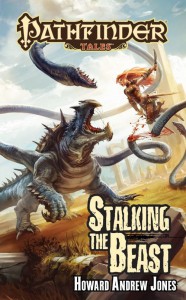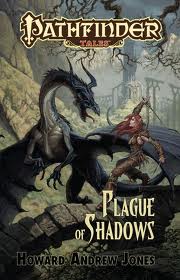Novel Lessons 4: Stalking the Beast
 After delivering a draft of The Bones of the Old Ones and while waiting upon editorial comments I wrote my second Pathfinder novel, Stalking the Beast. And while it proved much simpler in composition than writing Bones, it presented its own issues.
After delivering a draft of The Bones of the Old Ones and while waiting upon editorial comments I wrote my second Pathfinder novel, Stalking the Beast. And while it proved much simpler in composition than writing Bones, it presented its own issues.
By the time I sat down to write it I was beginning to understand that every novel has its own challenges. Stalking the Beast was a sequel novel to The Plague of Shadows, which was in some ways a search for identity by its protagonist, Elyana. By the end, Elyana was comfortable with herself and her past. I wasn’t entirely sure how to create a new struggle for someone who had found a way to get her sh*t together, so I decided to focus my efforts on her loyal half-orc friend, Drelm. Except that he was such a simple character I knew he couldn’t carry the narrative on his own.
Inspiration hit when I developed the third viewpoint character, Lisette, a gunslinger hired to kill Drelm. Her chapters were the easiest to write in the entire book, despite me knowing her the least. It was the oddest thing. Previous experience had shown me that knowing a character well was a great way into their head, but I learned that being INTERESTED in the character was real fuel as well. Lisette’s complicated life and motivations were so much more fun to write that they were vastly more simple to explore, so much so that I barely had to revise any of the chapters from her point of view at all.
It’s not that I didn’t LIKE Elyana or Drelm, it’s just that they weren’t as interesting to me now as Lisette. I enjoyed writing about her so much that I pitched the idea of writing some Lisette novels to James Sutter at GenCon after Stalking the Beast had come out, and he greenlit the idea in concept. Unfortunately I got so busy it never happened.
 I had experimented with structure in my first Pathfinder novel; in this one I experimented as well, building it around the three viewpoints. I kept the order throughout the narrative: one chapter from Elyana, one from Drelm, one from Lisette, then back to Elyana. It was a little tricky to build it and time events so that everyone would have something to do when their narrative came round, and even more challenging so at THAT particular moment their particular narrative would be the best angle to experience the story by. Of all the things I did in the book, I guess I’m proudest of that.
I had experimented with structure in my first Pathfinder novel; in this one I experimented as well, building it around the three viewpoints. I kept the order throughout the narrative: one chapter from Elyana, one from Drelm, one from Lisette, then back to Elyana. It was a little tricky to build it and time events so that everyone would have something to do when their narrative came round, and even more challenging so at THAT particular moment their particular narrative would be the best angle to experience the story by. Of all the things I did in the book, I guess I’m proudest of that.
When I discussed Plague of Shadows I mentioned that I had no great love for the use of healing magics, and that I prefer lower magic settings both when I game and when I write. You know, a feel that’s more sword-and-sorcery. When playing Pathfinder, a GM can set the grit level as high or as low as he or she and the players want. But it turns out the default preferred by many of the novel readers is more “high” fantasy, where magic is ubiquitous and easy to come by, and by the time I was drafting Stalking the Beast I was aware that a number of readers were questioning why I didn’t have magical healing in the first book. Magical healing is one of my least favorite game novel features, because with that and resurrection, no death really has much weight or impact. It’s hard to get that gritty sword-and-sorcery feeling with such powerful drama wreckers hanging out as possibilities.
So I threw in a powerful healer to the group — then had him killed pretty soon after the adventure started. Hah! That allowed me to go ahead and tell the grittier story I wanted and give lip service to the high magic feel. It was cheating, though, and I knew that I wouldn’t be able to do that again.
As I look back on it, I think the novel mostly works. I believe I took some potentially cliche archetypes and twisted and deepened them and even provided a surprise or two. I’m not sure I spent enough time explaining what the villain was really about. It wouldn’t have taken much more time, but it needed a few more lines. That problem came in part from the same issue I was wrestling with in The Bones of The Old Ones, when I hadn’t really known the villains well enough when I began to write. In THIS instance, the more personal villain to the characters — the one wanting to kill Drelm — is pretty well explored, but the one providing the larger threat didn’t get quite enough screen time.
Next week I’ll either look at some of the hard lessons I learned while working on the still-unfinished third Dabir and Asim novel, or move on to my third Pathfinder novel.
1 Comment